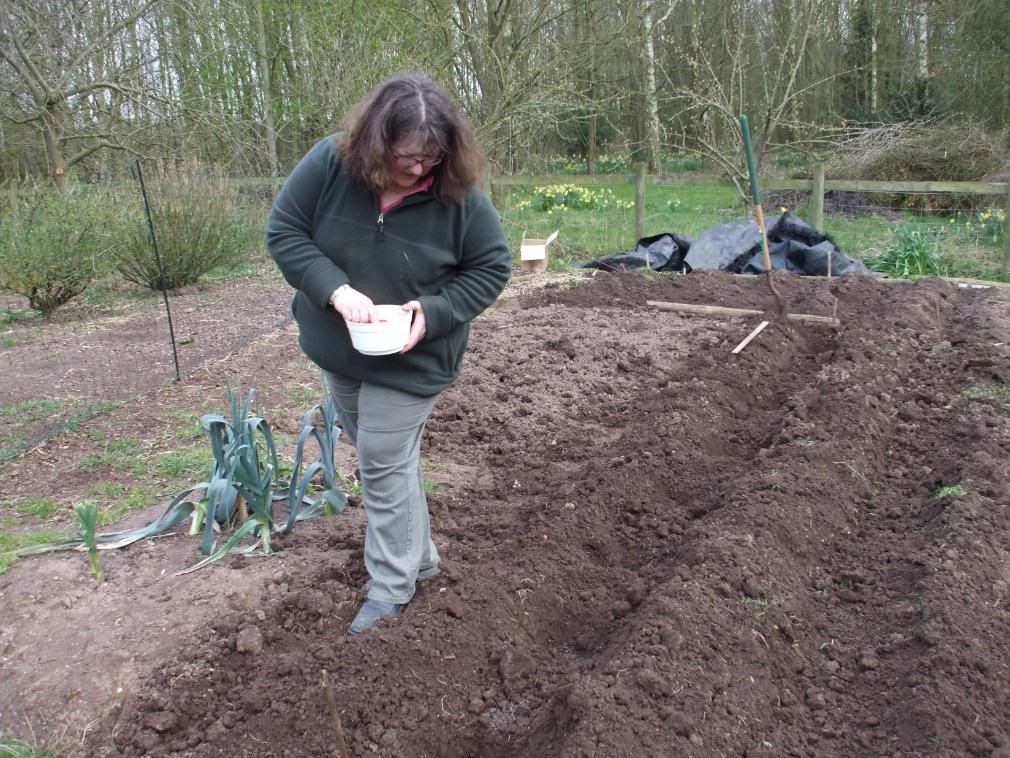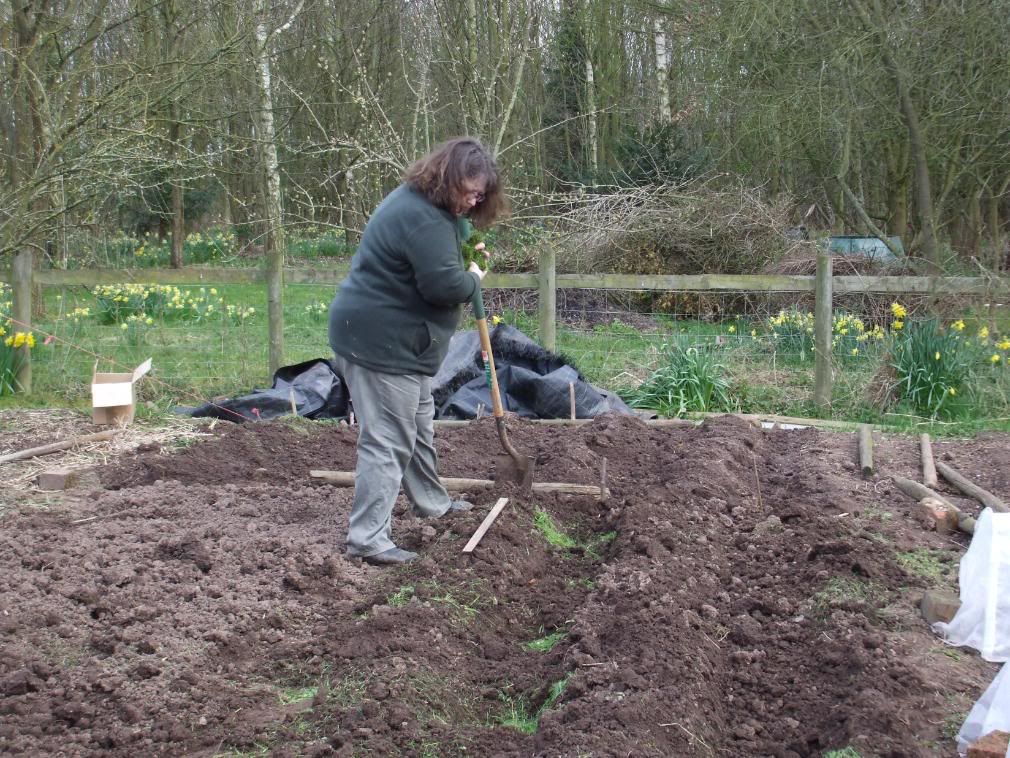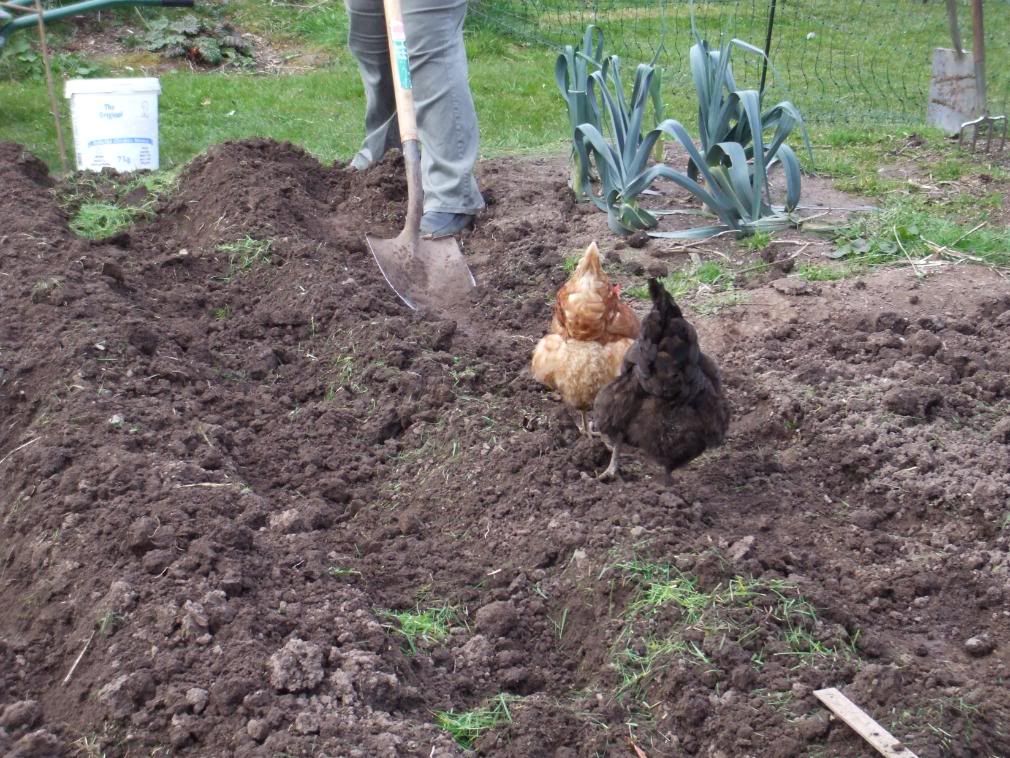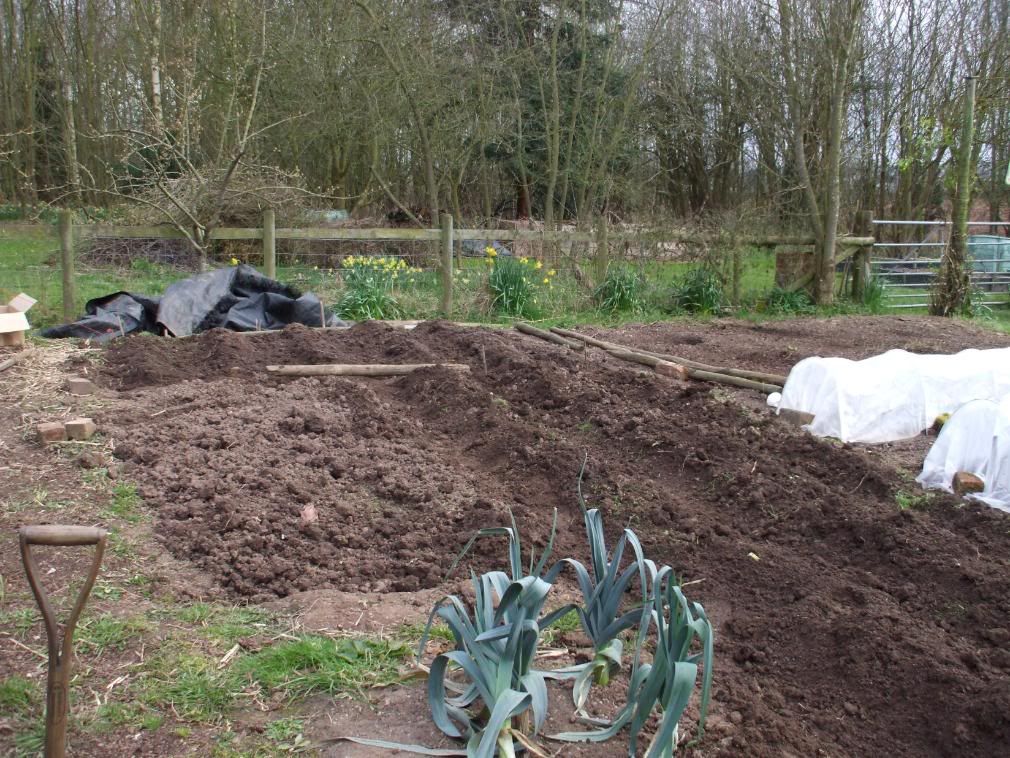 Potatoes
PotatoesTo avoid introducing pests and diseases into your crop, buy good quality, certified seed potatoes and start 'chitting' them as early as possible. This process encourages the tubers to produce strong, sturdy sprouts and gives an earlier maturing crop.
This is what you do:
Store the seed tubers in a light, cool (10°C), frost free spot and leave them to sprout. This is known as chitting. Place the tubers rose end up (the end where the tiny buds can be seen), in a clean box or tray. An egg box would be ideal, or a fruit tray from a supermarket ( the thick card ones are good!)
If you have more than one variety, label the box ( :-) )
Keep in a cool dark place.
When you see tiny shoots appearing move the tubers to a cool (8-10°C), light place.
Potatoes in the ground.
Dig in well-rotted manure or garden compost (apply no more than one wheelbarrow-full of well-rotted strawy manure, or two of compost, per 10 sq metres of ground) Plant tubers into trenches or in individual holes, 7-15cm in depth, cover with soil. See spacings below:
I make a shallow trench and then dig a hole for each tuber in the trench, this gives me soil to earth up the growing plants as required.
I use a shovel of my home made compost in each of the holes with a tuber in, plus a scoop of wood ash and a scoop of organic "Rooster" chicken manure (available from the Organic Gardening Catalogue).
1st early – 28-36cm apart, 38-50cm between rows.
2nd early & maincrop – 36-45cm apart, 65-75cm between rows.
Potato planting can start from mid March in milder areas, where frost is rare. If the soil is slow to warm, wait until April or May, or protect early plantings with fleece or cloches.





So I have been very busy planting spuds, as we are now into a waning moon!
I have already got the Earlies (Orla , Coleen) in the ground and I got 2 rows of Early Maincrop in this afternoon...a really nice waxy salad potato called "Nicola" which we have found keep as Maincrop really well.


Compostman dug over the ground for me and then I made some trenches and dropped each spud in a hole in the bottom of the trench, with some organic chicken poo pellets, wood ash and some grass clippings (they help prevent scab)

I then tucked the spuds up nice and warm with a good covering of soil....

Unfortunately Henny and Ginger thought all this was purely for THEIR benefit and came along

and rather destroyed my nice earthing up ridges of soil in between the trenches, but hey ho...never mind...I can rebuild them. The chickens are meant to be fenced out of the area of the veg plot but someone left the gate open....
Every year we grow enough spuds to last us from late June/early July until the following May... so we only buy potatos for about a month or so every year.
But in 2007 we lost virtually all our Maincrop harvest to blight (oh what a suprise, after all the wet weather we had!)
We had to start buying potatos in October!!
2008 was a bit better, because we had good weather in Feb and March I got the earlies and 2nd Earlies in, well..... early ;-)
so when the blight hit again, we had a good crop to harvest, which stored well.
So this year I am growing a lot more 2nd early varieties and only a few maincrop varieties and they will be in bags and tubs away from the veg plot so if blight DOES hit us I can keep a physical distance between the maincrop and the potato patch.
I am really hoping that, this year
a) The weather is better
b) Getting them in a bit earlier will help if we DO get blight again
c) I have spaced the rows out even further AND left a larger gap between each spud within the trench, so hopefully more air can get in between the potato plants.
d) I am not growing maincrop varieties which need a longer growing season to mature and so are worst affected by blight.
Fingers crossed!! That all this will help and once again we will have a decent harvest.

BUT We have put a 50 m length of electric fence netting around the veg garden so the hens cannot get in to dig everything up...
and they were VERY miffed that they couldn't get in to flatten the potato ridges I have made HOWEVER hard they tried!!
Potatoes are very tolerent so IF you have some earlies or early maincrop I WOULD get them in the ground or a grow bag NOW....even if they don't have big shoots on them....
Potatoes in grow sacks.
But what do you do if you don't have space in the ground?
You grow spuds in bags or pots, thats what!
To get an earlier crop I planted these in Feb on a waning moon. If you have a sheltered place you will get an earlier crop by doing this, up to 4 weeks earlier. Mmmmm new potatoes and butter




Jerusalem Artichokes
They are grown in the same spot each year, for if you miss a tuber it will grow like a volunteer potato, so prepare the ground well with plenty of manure which you can top up as a mulch in winter. Be careful where you site them, the foliage easily reaches 2 metres and 2.4 metres is common. The stems are quite delicate and you will need to provide support with stakes and string in windy locations.
Plant individual tubers about 40 to 60cm (15" to 24") apart around 12cm (4" to 6") deep in early spring and in a few weeks the shoots will appear. If you have more than one row, allow 75cm (30") between rows. When they reach about 30cm (12") high, earth up a little as for potatoes.
They are quite a productive crop, 3kg from one plant is typical so you don't need many seed tubers.

My parents used to have Jerusalem Artichokes. I loved them as a child but not sure if they still have them. My husband can't eat them. something about them makes him break out in a splotchy rash.
ReplyDeleteWe're planting our first attempt at potatoes this year so this information is timely. Thanks.
Judy
Thanks for the great post. Do you have any recipes for Jeruselum Artichokes?
ReplyDeleteBarb
What a lovely potato 'lesson' and just in the nick of time, all my potatoes are chitting away niceley and I was just wondering whether to actually get them into the couple of raised beds that we have almost finished preparing.
ReplyDeleteI think if we have no frost this weekend I may just plant them out.
Thanks for the inspiration and information.
Sue xx
Interesting about growing potatoes in bags. It looks very efficient in space. Unfortunately I could never grow enough to make it really worthwhile, given how dependent I am on potatoes in the winter....
ReplyDeleteOh, forgot to mention in the last post, wonderful advice about planting what one loves to eat. This year I am planting the things I can't get through my local farmer's CSA - things like opo squash, less-common kinds of eggplant, okra, etc. that my family and I love and eat often. Makes total sense. What are your favs? How do you decide what to plant each year?
Excellent!
ReplyDeleteI'm wanting to grow some spuds in pots, so I'm on the look-out for tips.
Btw - love the daffodils in the background of one of the pics there. Gorgeous. Looks like Spring is happening in your part of the world.
Also, just catching up on your news, and I'm very sorry about the loss of Genghis. Sounds like she had a lovely, peaceful life with you.
Hello, all!
ReplyDeleteSomeone asked about what length the shoots need to be on chitted spuds; well I have put them in the ground with shoots about an inch long, some longer. BUT it doesn't really matter.
Also apparently you get more and earlier spuds if you plant with the shoot pointing DOWN according to Bob Flowerdew on BBC Garderners World. It doesn't matter so much with maincrops but it DID matter with earlies and 2nd earlies....
counter intuitive, I know, but there you go...
Glad the post has been useful :-)
I love growing spuds - and have fun trying unknown varieties here in France. My First Early is called Dolwen and supposed to be very good. I must admit I only earth mine up after they start to shoot - otherwide I never seem to be able to get the mound actually over the growing spud. Still seems to work just as well.
ReplyDeleteI am growing J artichokes for the first time this year - I actually don't like them but one of my neighbours who buys veg from me does.
And I soooo know what you mean about chickens in the garden. I carefully mulched all my fruit bushes and my feathered friends scratched though and scattered it everywhere!!
Rosie x
Excellent! Thank you for this. I'm chitting some spuds at the moment but wasn't really sure when I should be planting them. Now I do! We've opted for grow sacks this year due to limited space - really looking forward to growing my own potatoes as we've not tried before. Never knew I could get so excited about veg... :) Great post. Thanks again!
ReplyDeletex
Wow you have been busy, I love the pics with chickens giving you some help, they're so good at doing that. Your daffs look lovely too, I'm still waiting for mine to flower - need some more sun!
ReplyDeleteOh, that was so helpful! We are still in the early phase of our self sufficient adventure.
ReplyDeleteI am fascinated by Jerusalem Artichokes. They are relatively unknown here.
How does one prepare them? (to eat I mean)
Neighbor Nancy
http://kitewrite.wordpress.com
Thanks for this post! I so need to get potatoes in the ground....and make room for some more.
ReplyDeleteA local Mennonite farmer here in Tennessee suggested sprinkling sulpher on the tops of the potato hills (after you plant and cover the potatoes) to prevent blight. This has worked for me for a a number of years now. Before using sulpher, I had lots of blight!
Wow!
ReplyDeleteLots of comments, as always!
Well I don't sprinkle sulphur but its a good idea I guess....as it seems to work where you are..but its not allowed under the organic regs I grow by..but I can see why it might help!
I really need to say this..sowing stuff isn't rocket science people!....stick it in the ground and , if it doesn't grow, just put in some more seed..................
and I suspect THAT will grow.......
there is a wide "window of opportunity" for growing stuff in the UK...and I suspect in most of the US of A...so...if it doesn't work first sowing..sow some more seed and try again..........
I learned to can in 2010 and immediately began experimenting with Jerusalem Artichokes, trying to recreate an old family recipe. Because I could only find one local source (I'm in Atlanta, GA US), and because I cleaned him out, I've decided to plant my own crop this year. Your information was very helpful. I am thinking of constructing a large raised bed dedicated to JA so my small garden plot isn't overrun with them.
ReplyDelete